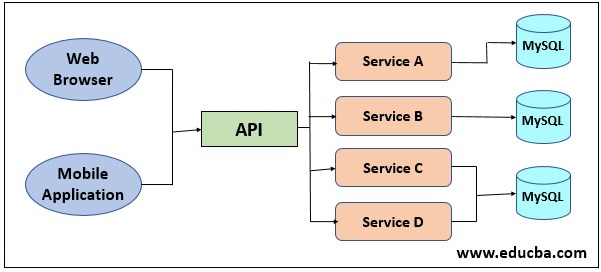Introduction to Advantages of Microservices
There are a lot of discussions going on around Microservices in all the IT companies. As a new trend emerges, every company has to adopt new technologies to sustain itself in the market. So what is the crux behind microservices? Why and how is it picking a boom around us? This article will discuss monolithic and microservice architecture, their differences, and their advantages and disadvantages.
Microservices = small services 1 + small service 2 + small service 3 + …
Monolithic Design
Monolithic design means built in a single piece. A technical definition could be a monolithic application with a single code base divided into multiple features. It has a single executable or deployable file. IT industries have been using this architecture for a very long time. Sometimes this architecture, also called multi-layer architecture divided into three or more layers.
Advantages & Disadvantages of Monolithic Architecture
Below are the advantages and disadvantages of Monolithic architecture:
Advantages
- Development is simple.
- Testing a monolithic application is easy. Just start the application to end-to-end testing, and you are good to go. We can also write automation using Selenium.
- Deployment is easy; copy the packaged application and deploy it on the server.
Many successful enterprise application has developed in a monolithic way. Monolithic architecture has worked successfully for decades. But changing the market with new technologies, there is a shift in how the IT industry works. So what happened exactly? Let us see the journey of how it all started.
Disadvantages
- A massive codebase makes it complicated to understand.
- Overload on IDE due to a massive codebase.
- Everything is tightly coupled, which makes it extremely difficult to change the technology or a framework.
- The application can slow the start-up time because it is too large.
- Applications with this architecture are challenging to scale.
- Reliability is a problem. Any bug fix can potentially bring down the entire process.
A Journey from Monolithic to Microservice
In the initial days, Industries focused more on desktop or laptop devices with web browsers as a client, which didn’t require any API to be exposed. But suddenly, the paradigm shifted from desktops/laptops to mobile and smart devices. Now enterprises need a different approach to serving the data. Every mobile application nowadays requires an internet connection. And every enterprise is now looking forward to developing mobile apps before the web. This led to a monolithic architecture to microservice architecture.
Microservice Architecture
Microservice architecture means building a large application with multiple small units called a service. Each of these services will be independently developed, tested, and deployed. Each service can communicate using the REST (Representational State Transfer) protocol. You have the option to run each service on a single machine or a separate machine. Each service can have its storage system. Microservice is all about breaking a larger system into small chunks. Every developer or team owns some part of a large application. But it does have some shortfalls. Let us first see the advantage and then the otherwise.
Advantages & Disadvantages of Microservice Architecture
Below are the advantages and disadvantages of microservice architecture:
Advantages
- It breaks down the application into small services (loosely coupled), making it faster to develop and maintain and much easier to understand.
- It enables each service to scale independently.
- This helps developers by allowing them to choose the technology that best suits their needs, removing any barriers to adopting new technologies.
- It allows a flexible way to integrate automatic deployment with continuous integration tools, e.g., Jenkins, Hudson, etc.
The terms loosely coupled and tightly coupled have considerable significance in development. If you want to know more about them, go out and look for them. You will find quite exciting discussions and articles about them. Coming back to our topic, we have looked into the benefits. Let us look into the shortfalls as well.
Disadvantages
- Microservices architecture is a distributed system; hence, you must build an intercommunication mechanism and handle partial failures.
- All the services may have storage, so you may have to use an eventual consistency-based approach. Which is more challenging for developers?
- In the monolithic application, it is easy to make changes in corresponding modules, but you have to plan and coordinate the changes to each service carefully in the microservice.
- A monolithic application can be deployed on identical servers behind the load balancer. But with microservices, each service has different instances, which must be configured, deployed, scaled, and monitored.
- Testing may also be difficult with microservice. One service may depend on others; hence, you might need to run multiple services together to test one service.
When we compare two things, it becomes very easy to understand behind the scenes. But before Microservice, a similar kind of architecture was already available in the market – SOA (Service Oriented Architecture). There are more similarities between Microservice and SOA than differences. And it could be quite tricky to differentiate between them. But yes, when you know it, you know it well; apart from knowing what Microservice is and the differences with other architecture, there is much more to learn about them. Springboot is an excellent framework for Java developers to build REST services. They are quite interesting to work on. So if you are interested, try to develop one.
Conclusion
Any architectural design has both the advantage and disadvantages of the side. It depends on the requirement of which architecture to choose. So know what you need and decide what’s best for it. Always look for best practices before you develop something.
Recommended Articles
We hope that this EDUCBA information on “Advantages of Microservices” was beneficial to you. You can view EDUCBA’s recommended articles for more information,





